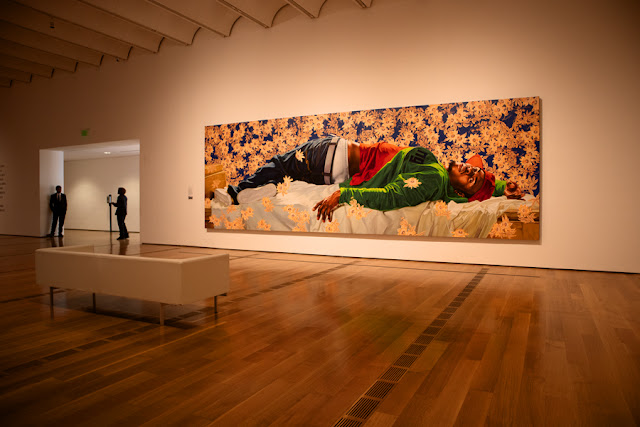 |
| Portraits of music icons Swizz Beatz and Alicia Keys, by artist Kehinde Wiley, flanked the entrance of the Giants exhibit at the High Museum of Art in Atlanta, GA. (Photo: blackartistnews.) |
Is the Minneapolis Institute of Art Missing in Action on Its Own Standards?
The Minneapolis Institute of Art (Mia) recently announced it will host Giants: Art from the Dean Collection of Swizz Beatz and Alicia Keys, an exhibition celebrating contemporary Black artists. Given the prestige of the collection and the influence of its collectors, this should be an exciting moment for the museum. However, Mia’s decision feels oddly contradictory—especially in light of its recent cancellation of a Kehinde Wiley exhibition due to harassment allegations against him.
This contradiction becomes even more glaring when considering that Giants prominently features Wiley’s work. His portraits of Swizz Beatz and Alicia Keys were a major part of the exhibit’s previous presentations at the Brooklyn Museum in New York and the High Museum of Art in Atlanta, where they were displayed at the entrance like guardian figures overseeing and protecting the space. Additionally, his painting Femme Piquée par un Serpent (2008) was included in both venues. Femme reinterprets the classical European motif of a woman in distress, based on Auguste Clésinger’s 19th-century sculpture of the same name, by replacing the woman with a young Black man dressed in contemporary urban fashion. This creates a striking contrast to the original work, with the figure's confident pose and vibrant, intricate background challenging traditional notions of victimhood and offering a modern reinterpretation of power, race, and identity.In various interviews and conversations, Beatz has discussed how he acquired the painting, its significance to the Dean Collection and that he and Keys consider Wiley a "close friend." Wiley even appeared in a national news feature to promote Giants at the Brooklyn Museum. Unless Mia plans to edit these pieces out—an alteration that would fundamentally change the collection’s presentation—Wiley’s work will now be on view at a museum that, just months ago, deemed his solo exhibition unacceptable.
So, what changed? If the allegations were reason enough to cancel one show, why is it acceptable to display his work in another context? If the museum is taking a principled stand, this move weakens its position. If the decision was about optics, this only makes the inconsistency more apparent. Either way, the message is unclear.
Museums shape cultural narratives through the choices they make, and those choices should be consistent. By canceling Wiley’s solo show while still displaying his work in Giants, Mia leaves us with more questions than answers.
So, what changed? If the allegations were reason enough to cancel one show, why is it acceptable to display his work in another context? If the museum is taking a principled stand, this move weakens its position. If the decision was about optics, this only makes the inconsistency more apparent. Either way, the message is unclear.
Museums shape cultural narratives through the choices they make, and those choices should be consistent. By canceling Wiley’s solo show while still displaying his work in Giants, Mia leaves us with more questions than answers.
 |
| Installation view of Kehinde Wiley's Femme Piuée par un Serpent in Giants at High Museum of Art, Atlanta, GA. (Photo: blackartistnews) |

No comments:
Post a Comment